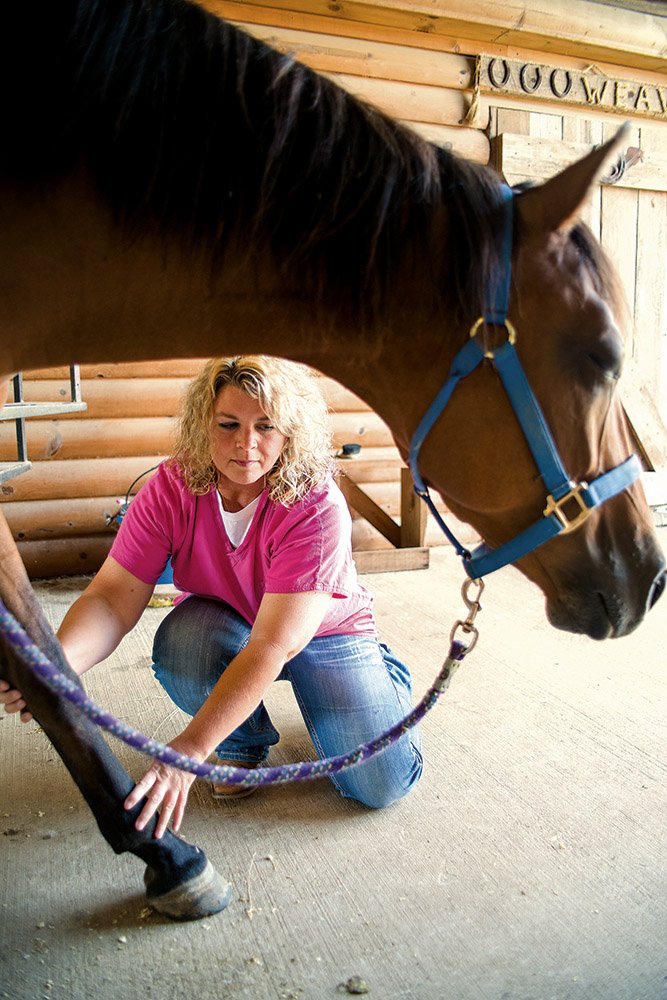As Shelia Weaver began to gently massage Miss Kitty’s neck, the mare soon dropped her head as she began to relax. As Weaver continued applying light pressure to the area, she watched Miss Kitty for “signs” of tension release.
“Maybe she’ll begin to lick,” Weaver said quietly as she worked in her horse barn near Shirley. “That’s a sign of tension being released. Other signs may be chewing, yawning or sneezing. When they do that, you know the tension is gone.”
Weaver’s husband, Michael, said, “I’ve even seen a horse lie down and go to sleep after she’s worked on him.”
Weaver, 46, is a licensed massage therapist and, most recently, became a certified equine practitioner of the Masterson Method. In short, she performs massage therapy on horses. She calls her specialty business Extra Edge Equine Sports Therapy.
A native of Clinton, Weaver holds an associate degree in animal science from Arkansas State University-Beebe.
“I was a veterinarian assistant for 23 years,” she said. “I went to massage school during that time and even had my own massage therapy clinic in Clinton for a while.”
Weaver said she first became interested in equine sports therapy when she
took a horse to a veterinar-
ian who was also a chiropractor.
“He told me the horse was too sore for him to work on and suggested I take him home and use massage therapy on him for two weeks and then bring him back,” she said. “I had no idea what to do. I asked myself, ‘Do I treat him like a person?’ I tried that, but it didn’t work too well.”
That’s when Weaver found Jim Masterson of Fairfield, Iowa, and Masterson Equine Services.
“He goes all over the United States and North America practicing and teaching his method,” Weaver said. “He’s the equine sports therapist for the United States equestrian teams. I took his training course, traveling to Lexington, Ky., and Austin, Texas. It took me about nine months to become certified, about the same amount of time it takes to complete a human-massage-therapy training course.
“I’ve been doing this full time for about five years,” she said. “I take continuing-education courses, at least one every year.”
Weaver makes “house calls,” or the client can bring the horse to her barn.
“I spend a lot of time
in training barns,” she said with a smile. She said she
usually works with a horse for 1 ½ to two hours a day,
completing a full body massage as the horse remains standing.
“I work mainly with performance horses,” she said. “It’s seasonal, corresponding with rodeos and horse shows. I also do a little bit of rehabilitation work.
“The last horse I rehabilitated was a violent bucker. I got him in January and released him in April. Since then, he has placed third at the World Championship Palomino Horse Show in Tunica, Miss. He did well. I am really proud of him.”
Weaver said it’s often hard for the horse owner to know the horse is hurting.
“Sadly, they have no voice to tell us,” she said. “We have to really be in tune with the horse to know he’s in pain. A lot of the time a horse is labeled a troublemaker or ill-tempered. That behavior may be the result of being sore or hurting. They refuse to do what is asked of them because it’s painful.
“But the horse knows if he doesn’t perform, he will be reprimanded. So he continues to work, compensating for the pain, for years. Finally, he gets to the point where there is nothing left to compensate with.
“My goal is to get them back in the show ring.”
But if that is not possible, she said, she hopes to find other jobs for the horses.
Weaver said she wants to educate the public about equine sports therapy.
“People need to realize that horses are athletes,
and they work hard,” she said. “It’s like owning a car. Do you change the oil on a regular basis or just let it go until the car just quits?
“Maintenance is most important.”
Weaver said she grew up around horses, riding and showing cutting and reining horses.
“Honestly, I was one of those people who didn’t recognize that my horse
might be in pain because he didn’t stop as quickly as I wanted him to during a
performance,” she said. “I didn’t stop to think he
might be hurting somewhere.”
Weaver is available to speak to groups about equine sports therapy.
“This is something I am very passionate about,” she said, adding that she uses acupressure and myofascial release therapy techniques on horses if needed. “I can tell by looking if a horse is sore, especially by looking at its gait.”
